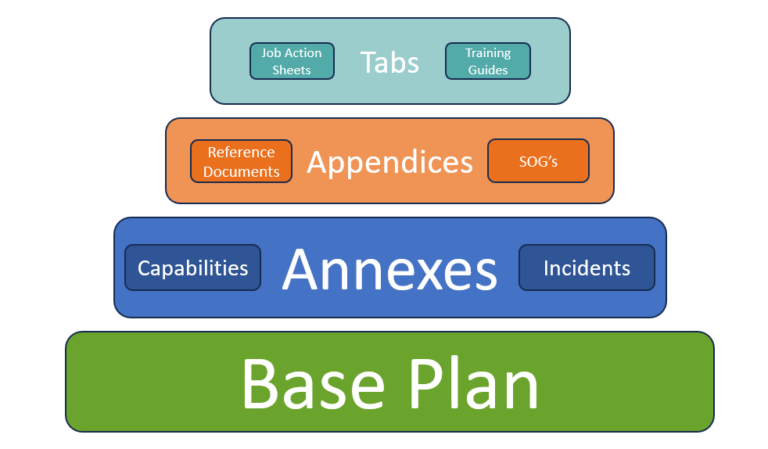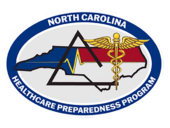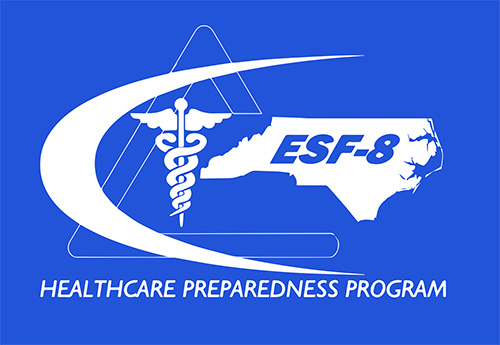NC Office of EMS
Emergency Operations Plan Structure
The North Carolina Office of Emergency Medical Services (NCOEMS) Healthcare Preparedness Program is responsible for the maintenance and updates to the NCOEMS Emergency Operations Plan (EOP). The plan outlines the key roles and responsibilities of NCOEMS as lead agency for Disaster Medical Services as part of the State Emergency Response Team (SERT). For more information about the overall North Carolina Emergency Operations Plan and the State Emergency Response Team, please visit the North Carolina Department of Public Safety website.
The NCOEMS EOP is categorized into four parts: The base plan, annexes, appendices, and tabs.
- The base plan includes how Disaster Medical Services are organized and outlines specific capabilities.
- The annexes provide a framework for the eight Disaster Medical Services capabilities.
- The appendices deep dive into the concept of operations for various mission types assigned to the Disaster Medical Services.
- The tabs provide granular details, guidelines, and training aids for specific roles and responsibilities within each appendix (e.g, standard operating guidelines, reference documents, and job action sheets).
The image below is illustrative of the NCOEMS Healthcare Preparedness Program’s Emergency Operations Plan structure:

Plan Links
*** Some plans contain sensitive emergency response information and have been removed from the published EOP. Please contact our staff if you need additional assistance regarding these documents. Unpublished plans are noted below with an asterisk.
Base Plan
- Base Plan (with Appendix 1-7 and Tab 4A & 4B)
- Base Plan (Base Plan Only)
-
- Appendix 1: Shift Duty Officer Standard Operating Guidelines
- Appendix 2: ESF8 State EOC Activation Checklist
- Appendix 3: ESF8 SEOC-Support Cell Staffing & Sustainment
- Appendix 4: Medical Resource Management
- Appendix 5: Communications & Information Management
- Appendix 6: Organization & Assignment of Responsibilities
- Appendix 7: Demobilization
-
Annex A – Administrative Preparedness
This annex addresses the ability to conduct and maintain administrative functions necessary for the execution and proper documentation of ESF8 emergency response and recovery operations. It provides guidelines and information including, the recording of responder time and activities, emergency purchase processes, and FEMA reimbursement.
UNDER REVIEW
- Annex A: Administrative Preparedness (IN – PROGRESS)
Annex B – Healthcare System Recovery
This annex addresses the strategic priorities, organization, and concept of operations for recovery activities supported by the State Medical Response System necessary to provide continued delivery of essential healthcare services after a disaster or emergency.
Annex C – Medical Surge
This annex addresses the ability to provide adequate medical coverage during incidents that severely challenge or exceed the normal medical infrastructure of an affected community (through numbers or types of patients). It covers plans and guidelines for support of the healthcare system during incidents resulting in medical surge conditions.
- Annex C: Medical Surge (with Appendix C1-C2 and Tabs C1A-C2C)
- Annex C: Medical Surge (Annex Only)
Annex D – Patient Movement
This annex addresses the ability to triage and place patients in appropriate receiving facilities and develops a structure for the coordination of transportation for patients. It covers plans and processes for state-coordinated patient movement when local jurisdictions require regional, state, or
federal assistance to manage patient movement including evacuation of existing healthcare facilities.
Annex E – HPP Continuity of Operations
This annex addresses the implementation and management for the Healthcare Preparedness Program’s Continuity of Operations. This plan outlines the essential functions of the program and plans to ensure their ability to be maintained during various emergencies and disasters.
HOLD PLANNED FUTURE ANNEX
- Annex E: Healthcare Preparedness Program Continuity of Operations (Planned Future Annex)
-
- Appendix E1: Cybersecurity Incident Response Plan ***
-
- Tab E1A: Information Technology Services and Programs ***
-
- Appendix E1: Cybersecurity Incident Response Plan ***
-
Annex F – Situational Awareness & Information Sharing
This annex addresses the ability to provide and maintain situational awareness and share information regarding ESF8 response/recovery operations during an emergency or disaster. It covers guidelines for the collection and dissemination of information, use of briefings and conference calls, and use of messaging systems.
Annex G – Healthcare Services in Shelters
This annex addresses the ability to maintain continuity of healthcare through the establishment, operation, and/or support for healthcare services in state-run shelters. It covers plans and guidelines for State-Operated Shelters (SOS) and State Medical Support Shelters (SMSS).
- Annex G: Healthcare Services in Shelters (with Appendix G1-G2 & Tab G1A-G2G)
- Annex G: Healthcare Services in Shelters (Annex Only)
Annex H – State Medical Response System
This annex addresses the ability of the North Carolina State Medical Response System to support overwhelmed healthcare infrastructure by supplying the necessary equipment, assets, and/or personnel needed to provide medical care during emergencies and disasters. It covers plans and guidelines for the components of the State Medical Response System (SMRS).
UNDER REVIEW
- Annex H: State Medical Response System (IN – PROGRESS)

